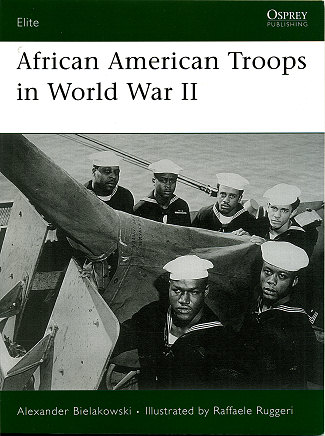 The
world of nearly 70 years ago was a very different place in many respects. This
was particularly true in the United States were a goodly segment of its
population was treated as second-class citizens. Basically, if you were not of
European descent, then the ability to succeed in life was a constant struggle.
This was particularly true of African Americans, who were held back by wide
ranging prejudices in all aspects of life, and that included military service.
The
world of nearly 70 years ago was a very different place in many respects. This
was particularly true in the United States were a goodly segment of its
population was treated as second-class citizens. Basically, if you were not of
European descent, then the ability to succeed in life was a constant struggle.
This was particularly true of African Americans, who were held back by wide
ranging prejudices in all aspects of life, and that included military service.
However, the needs of the war eventually broke down many of
the barriers though probably not as much as was initially hoped. Prejudice is a
difficult thing to eliminate and many will tell you that it still exists, though
no where at the level that it was in the early 1940s.
During that time, there were few black soldiers, few black
sailors and no black marines or airmen.
It was realized that no manpower could be wasted so these men
were recruited and allowed to join the various services. The Army had the
largest cadre and several avenues to command were available, though this was
still quite limited in scope. Probably the most successful group was the 332nd
Fighter Group; the Tuskeegee Airmen. These men showed that race had nothing to
do with abilities and in spite of horrendous hurdles, served with distinction.
Other units were not so lucky and were mired in overwhelming prejudice from
white commanders who would do all they could to ensure failure. This was also
shown in many Army combat units. Some were successful, while others were not.
The Navy always had black sailors, though these men were
generally restricted in scope to service ratings. As the war went on, these men
also were able to serve, albeit on mostly black crewed ships. The Marines were
the most resistant to men of color and so had to be forced to recruit men into
the service. These men often served in supply and defense units, so did not see
as much combat as they could, though ironically, the supply units saw
considerably more combat than did the defense units.
Finally, there was the Coast Guard. Again, it started out
mostly white, though it had the vision to integrate black sailors in with
standard white crews. It found, as we knew it would, that there was no problems
with racial intermixing in the crew, and the ships operated just fine.
Author Bielakowski tells the story of these men service by
service and covers some of the greatest successes as well as some of the
failures. This is all enhanced by quality period photos and the illustrations of
R. Ruggeri.
In all, a superb book on a part of WWII that gets very little
press. A book I can justifiably recommend to you.
December 2007
For more on the complete line of Osprey books,
visit www.ospreypublishing.com. In the US, it is
Osprey Direct at 44-02 23rd St, Suite 219, Long Island City, NY 11101., where you can
get a catalogue of available books.
If you would like your product reviewed fairly and quickly, please contact
me or see other details in the Note to
Contributors.
 The
world of nearly 70 years ago was a very different place in many respects. This
was particularly true in the United States were a goodly segment of its
population was treated as second-class citizens. Basically, if you were not of
European descent, then the ability to succeed in life was a constant struggle.
This was particularly true of African Americans, who were held back by wide
ranging prejudices in all aspects of life, and that included military service.
The
world of nearly 70 years ago was a very different place in many respects. This
was particularly true in the United States were a goodly segment of its
population was treated as second-class citizens. Basically, if you were not of
European descent, then the ability to succeed in life was a constant struggle.
This was particularly true of African Americans, who were held back by wide
ranging prejudices in all aspects of life, and that included military service.